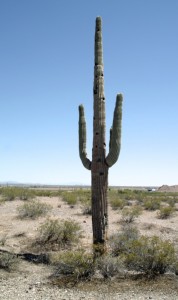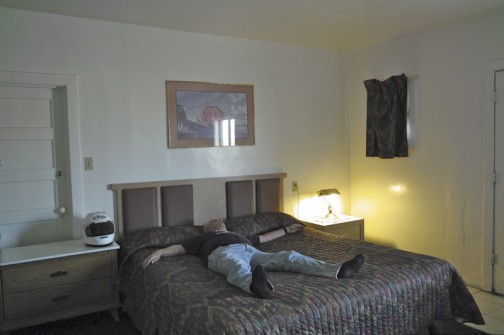INTO THE GUN BELT
Even if you don’t get broadsided by a Buick or steamrolled by a semi, motorcycling is still hard on your body. My knee joints are swollen; my back aches and my butt is sore. I’m suffering from what’s known as “numb thumbs,” which is similar to “cold dead fingers”—an affliction prevalent in Southern Arizona according to what I’ve read on many a bumper sticker. Numb thumbs come from holding on tightly to one’s handlebars for hours at a stretch, which is what I’ve been doing in order not to lose control when hitting a bump or falling into a pothole. I also have eye strain, the result of constantly monitoring the road surface for bumps, potholes, grooves, upheavals, fissures, pea gravel, oil slicks, tar babies, litter, broken glass, wildlife, livestock, et al. So now my eyeballs are throbbing and I can’t make out the fine print on my road map.
What I’m trying to avoid are major highways and Interstates leading to the Phoenix metroplex, which, like Darth Vader’s tractor beam, draws in heliotropic senior citizens from colder climes farther north. Since I last passed through in the fall of 1968 the population has grown tremendously. Even though I, too, am a senior citizen, I want no part of it.
In the motel parking lot, a bunch of Girl Scouts are selling cookies. Eager to earn Brownie points, they volunteer to help boost me onto my very tall saddle. Thanks, girls, for your service!
Highway 89A takes me to Interstate 17, on which I’m briefly stuck until Camp Verde, where I exit onto State Route 260, and soon I’m back in the forested high country where the weather suits MY clothes. Traffic is light and consists mostly of motorcycles. Oncoming riders give me a wave and of course I wave back. Only those riding Gold Wings and Can Am Spyders don’t wave. I’m guessing that if your scooter weighs as much as a Winnebago or has training wheels, you’re not really a bona fide member of the motorcycling community.
South of Payson, I make a big mistake and stay on highway 87 instead of exiting onto 188. As a result, I find myself shedding altitude. Yellow pines give way to cacti; traffic picks up, and the lanes divide. Shit! I’m being drawn into the Phoenix metroplex. Nothing I can do about it until I get to Mesa—or is it Scottsdale? Or Tempe? Who can tell; they all look the same. I pick my way through heavy traffic to the 202 and proceed eastward through suburban sprawl until I get to Apache Junction, which turns out to be just more suburban sprawl. Off to the north, at the far end of a vast sea of little dun-colored boxes, rise the Superstition Mountains. Now at last I know how the Dutchman lost track of his gold mine. He couldn’t tell one lookalike suburb from another!
At Florence Junction I’m finally able to turn southward again. Like the Dutchman, I’m still a bit disoriented; however, one thing is certain: I AM in America! The stars and stripes are on display everywhere, from fast food joints to military bases. Gun stores, shooting ranges, bombing ranges, concealed-carry academies, Carl’s Jr.—you name it. At a historic site called Tom Mix Wash, I pull off the highway to take a piss. In the distance I can hear the pop, pop, pop of a semiautomatic pistol. An A-10 Warthog armed with a 30mm Gatling gun roars overhead. Lizards and horned toads scurry for cover; a saguaro cactus raises its prickly arms skyward in a submissive gesture. Hands up, don’t shoot!
By late afternoon I find myself caught up in the Tucson Tractor Beam. Tucson, too, has grown significantly since 1968. When I rolled into town then, I was greeted by two young women on a motor scooter, who escorted me to a Frostee Freez. Today, however, there is no Frostee Freez in sight. That’s because Tucson has a very strict building code. Every business, be it a bank, apartment building, massage parlor or restaurant, must look exactly the same. Signs and company logos are so small that I can’t make them out. I’m searching desperately for a motel, but all I see are dun-colored low-rises.
For what seems forever I’m stuck in stop-and-go traffic until at last I spot something that resembles a motel—the sort of motel that would be familiar to, say, Tom Joad. The office is locked, but when I press the doorbell a frail woman in a sari opens the door. Quickly, she retreats to the other side of a bulletproof partition. I push 45 dollars through the slot and she pushes me the key to room three. Then she comes out from behind the bulletproof partition and escorts me to my room. Turns out two keys—hers and mine—are required to unlock the door. So, like a bank safety deposit box or a minuteman missile silo, the Tiki Motel is a secure facility—no matter that I’ve had the opportunity to murder the proprietor twice already.
The room itself is, well, a room. Not nearly as nice as the one in Kokopelli, although my window does command a view of a swimming pool. Said swimming pool, alas, has been filled in with dirt. Doesn’t matter, because I’m much too worn out to go for a swim. Before I can even undress I’m as dead to the world as the light bulb above the sink in the pink and blue tiled bathroom.


